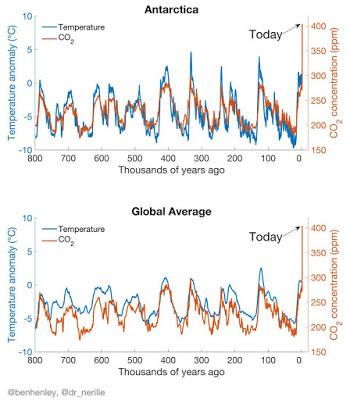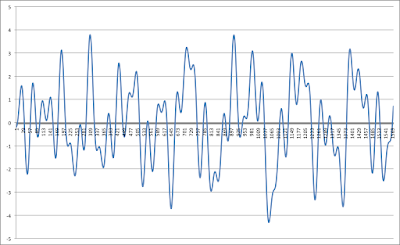There are lots of people like Piers Corbyn who reckon that the weather/climate is influenced by lots of things that go in cycles (he reckons that the main influence is changes in the sun's output) and repeat themselves if you look hard enough. Corbyn's forecasts are apparently very good, but the Alarmists dismiss him because he's only forecasting weather and not climate.
Some of these cycles are widely accepted, such as solar 11 year cycles, which possibly form double-cycles of 22 years, ocean oscillations, Milanković cycles (which are actually four quite distinct cycles with wildly different periods).
Some of them are more conjecture, such as Zharkova's longer solar cycles and sixty year cycles.
Some of these will turn out to be misunderstandings, and there will be others which we don't know about yet.
------------------------------
If you look at the temperature chart from The Conversation, which purports to show that CO2 levels dictate temperatures, what you see is that:
a) there are clear 100,000-year cycles (Milanković cycles, I believe) and everything else is just noise and apparently random variations,
b) temperatures in the current inter-glacial period are very similar to the previous seven, and
c) if CO2 levels dictated temperatures in the way the chart implies, it would be about 10C hotter than it is, which it clearly isn't. So we can rule out minor changes in CO2 levels (a change of one per cent of one per cent of the atmosphere by volume) as being relevant.

The article itself agrees that in pre-industrial times, temperature drove CO2 levels and not the other way round, and goes to some contortions to explain why that relationship has now flipped.
For more contorted explanations, go to the article at Skeptical Science. This site is reliably Alarmist but infuriatingly enjoyable - it's like reading an editorial in The Sun newspaper, you know it's propaganda but it's so expertly done, that on a first read it seems quite convincing and you have to look quite hard to spot the false logical steps.
-------------------------------------------
I imagine it is fiendishly difficult to disaggregate overlapping but independent cycles. So well done Milanković, who did all this by hand and doesn't appear to have got credit until after he died (see also Kondratiev).
Just for fun, I set up and Excel spreadsheet with sine waves cycling between +1 and -1 with periods 2, 3, 5, 7, 11 and 13. A chart of the totals looks pretty random, those occasional outliers of +4 or -4 look like extreme or random events, but they are not, they are entirely predictable if you know the inputs:

